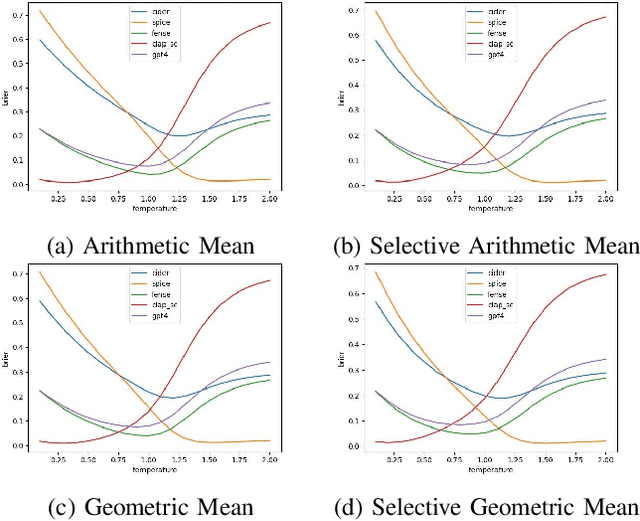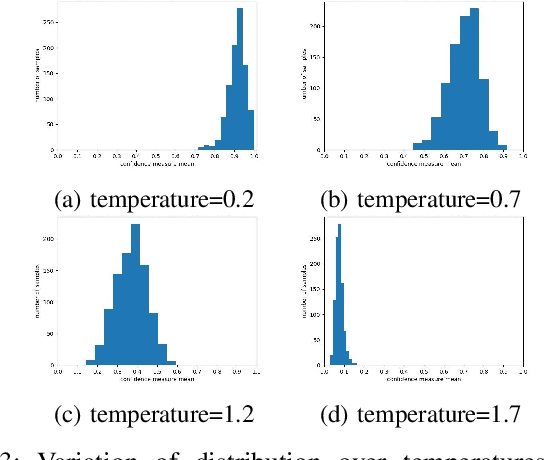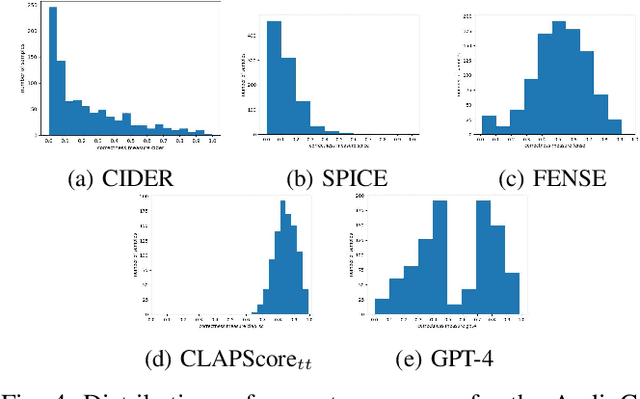Erik Visser
Aligning Audio Captions with Human Preferences
Sep 18, 2025Abstract:Current audio captioning systems rely heavily on supervised learning with paired audio-caption datasets, which are expensive to curate and may not reflect human preferences in real-world scenarios. To address this limitation, we propose a preference-aligned audio captioning framework based on Reinforcement Learning from Human Feedback (RLHF). To effectively capture nuanced human preferences, we train a Contrastive Language-Audio Pretraining (CLAP)-based reward model using human-labeled pairwise preference data. This reward model is integrated into a reinforcement learning framework to fine-tune any baseline captioning system without relying on ground-truth caption annotations. Extensive human evaluations across multiple datasets show that our method produces captions preferred over those from baseline models, particularly in cases where the baseline models fail to provide correct and natural captions. Furthermore, our framework achieves performance comparable to supervised approaches with ground-truth data, demonstrating its effectiveness in aligning audio captioning with human preferences and its scalability in real-world scenarios.
Spatial Audio Motion Understanding and Reasoning
Sep 18, 2025Abstract:Spatial audio reasoning enables machines to interpret auditory scenes by understanding events and their spatial attributes. In this work, we focus on spatial audio understanding with an emphasis on reasoning about moving sources. First, we introduce a spatial audio encoder that processes spatial audio to detect multiple overlapping events and estimate their spatial attributes, Direction of Arrival (DoA) and source distance, at the frame level. To generalize to unseen events, we incorporate an audio grounding model that aligns audio features with semantic audio class text embeddings via a cross-attention mechanism. Second, to answer complex queries about dynamic audio scenes involving moving sources, we condition a large language model (LLM) on structured spatial attributes extracted by our model. Finally, we introduce a spatial audio motion understanding and reasoning benchmark dataset and demonstrate our framework's performance against the baseline model.
Mitigating Intra-Speaker Variability in Diarization with Style-Controllable Speech Augmentation
Sep 18, 2025Abstract:Speaker diarization systems often struggle with high intrinsic intra-speaker variability, such as shifts in emotion, health, or content. This can cause segments from the same speaker to be misclassified as different individuals, for example, when one raises their voice or speaks faster during conversation. To address this, we propose a style-controllable speech generation model that augments speech across diverse styles while preserving the target speaker's identity. The proposed system starts with diarized segments from a conventional diarizer. For each diarized segment, it generates augmented speech samples enriched with phonetic and stylistic diversity. And then, speaker embeddings from both the original and generated audio are blended to enhance the system's robustness in grouping segments with high intrinsic intra-speaker variability. We validate our approach on a simulated emotional speech dataset and the truncated AMI dataset, demonstrating significant improvements, with error rate reductions of 49% and 35% on each dataset, respectively.
Voice-ENHANCE: Speech Restoration using a Diffusion-based Voice Conversion Framework
May 21, 2025Abstract:We propose a speech enhancement system that combines speaker-agnostic speech restoration with voice conversion (VC) to obtain a studio-level quality speech signal. While voice conversion models are typically used to change speaker characteristics, they can also serve as a means of speech restoration when the target speaker is the same as the source speaker. However, since VC models are vulnerable to noisy conditions, we have included a generative speech restoration (GSR) model at the front end of our proposed system. The GSR model performs noise suppression and restores speech damage incurred during that process without knowledge about the target speaker. The VC stage then uses guidance from clean speaker embeddings to further restore the output speech. By employing this two-stage approach, we have achieved speech quality objective metric scores comparable to state-of-the-art (SOTA) methods across multiple datasets.
Comprehensive Audio Query Handling System with Integrated Expert Models and Contextual Understanding
Dec 05, 2024



Abstract:This paper presents a comprehensive chatbot system designed to handle a wide range of audio-related queries by integrating multiple specialized audio processing models. The proposed system uses an intent classifier, trained on a diverse audio query dataset, to route queries about audio content to expert models such as Automatic Speech Recognition (ASR), Speaker Diarization, Music Identification, and Text-to-Audio generation. A 3.8 B LLM model then takes inputs from an Audio Context Detection (ACD) module extracting audio event information from the audio and post processes text domain outputs from the expert models to compute the final response to the user. We evaluated the system on custom audio tasks and MMAU sound set benchmarks. The custom datasets were motivated by target use cases not covered in industry benchmarks and included ACD-timestamp-QA (Question Answering) as well as ACD-temporal-QA datasets to evaluate timestamp and temporal reasoning questions, respectively. First we determined that a BERT based Intent Classifier outperforms LLM-fewshot intent classifier in routing queries. Experiments further show that our approach significantly improves accuracy on some custom tasks compared to state-of-the-art Large Audio Language Models and outperforms models in the 7B parameter size range on the sound testset of the MMAU benchmark, thereby offering an attractive option for on device deployment.
Confidence Calibration for Audio Captioning Models
Sep 13, 2024



Abstract:Systems that automatically generate text captions for audio, images and video lack a confidence indicator of the relevance and correctness of the generated sequences. To address this, we build on existing methods of confidence measurement for text by introduce selective pooling of token probabilities, which aligns better with traditional correctness measures than conventional pooling does. Further, we propose directly measuring the similarity between input audio and text in a shared embedding space. To measure self-consistency, we adapt semantic entropy for audio captioning, and find that these two methods align even better than pooling-based metrics with the correctness measure that calculates acoustic similarity between captions. Finally, we explain why temperature scaling of confidences improves calibration.
Enhancing Temporal Understanding in Audio Question Answering for Large Audio Language Models
Sep 10, 2024Abstract:The Audio Question Answering task includes audio event classification, audio captioning, and open ended reasoning. Recently, Audio Question Answering has garnered attention due to the advent of Large Audio Language Models. Current literature focuses on constructing LALMs by integrating audio encoders with text only Large Language Models through a projection module. While Large Audio Language Models excel in general audio understanding, they are limited in temporal reasoning which may hinder their commercial applications and on device deployment. This paper addresses these challenges and limitations in audio temporal reasoning. First, we introduce a data augmentation technique for generating reliable audio temporal questions and answers using an LLM. Second, we propose a continued finetuning curriculum learning strategy to specialize in temporal reasoning without compromising performance on finetuned tasks. Finally, we develop a reliable and transparent automated metric, assisted by an LLM, to measure the correlation between Large Audio Language Model responses and ground truth data intelligently. We demonstrate the effectiveness of our proposed techniques using SOTA LALMs on public audio benchmark datasets.
VC-ENHANCE: Speech Restoration with Integrated Noise Suppression and Voice Conversion
Sep 10, 2024Abstract:Noise suppression (NS) algorithms are effective in improving speech quality in many cases. However, aggressive noise suppression can damage the target speech, reducing both speech intelligibility and quality despite removing the noise. This study proposes an explicit speech restoration method using a voice conversion (VC) technique for restoration after noise suppression. We observed that high-quality speech can be restored through a diffusion-based voice conversion stage, conditioned on the target speaker embedding and speech content information extracted from the de-noised speech. This speech restoration can achieve enhancement effects such as bandwidth extension, de-reverberation, and in-painting. Our experimental results demonstrate that this two-stage NS+VC framework outperforms single-stage enhancement models in terms of output speech quality, as measured by objective metrics, while scoring slightly lower in speech intelligibility. To further improve the intelligibility of the combined system, we propose a content encoder adaptation method for robust content extraction in noisy conditions.
Stylebook: Content-Dependent Speaking Style Modeling for Any-to-Any Voice Conversion using Only Speech Data
Sep 12, 2023



Abstract:While many recent any-to-any voice conversion models succeed in transferring some target speech's style information to the converted speech, they still lack the ability to faithfully reproduce the speaking style of the target speaker. In this work, we propose a novel method to extract rich style information from target utterances and to efficiently transfer it to source speech content without requiring text transcriptions or speaker labeling. Our proposed approach introduces an attention mechanism utilizing a self-supervised learning (SSL) model to collect the speaking styles of a target speaker each corresponding to the different phonetic content. The styles are represented with a set of embeddings called stylebook. In the next step, the stylebook is attended with the source speech's phonetic content to determine the final target style for each source content. Finally, content information extracted from the source speech and content-dependent target style embeddings are fed into a diffusion-based decoder to generate the converted speech mel-spectrogram. Experiment results show that our proposed method combined with a diffusion-based generative model can achieve better speaker similarity in any-to-any voice conversion tasks when compared to baseline models, while the increase in computational complexity with longer utterances is suppressed.
Highly Controllable Diffusion-based Any-to-Any Voice Conversion Model with Frame-level Prosody Feature
Sep 06, 2023



Abstract:We propose a highly controllable voice manipulation system that can perform any-to-any voice conversion (VC) and prosody modulation simultaneously. State-of-the-art VC systems can transfer sentence-level characteristics such as speaker, emotion, and speaking style. However, manipulating the frame-level prosody, such as pitch, energy and speaking rate, still remains challenging. Our proposed model utilizes a frame-level prosody feature to effectively transfer such properties. Specifically, pitch and energy trajectories are integrated in a prosody conditioning module and then fed alongside speaker and contents embeddings to a diffusion-based decoder generating a converted speech mel-spectrogram. To adjust the speaking rate, our system includes a self-supervised model based post-processing step which allows improved controllability. The proposed model showed comparable speech quality and improved intelligibility compared to a SOTA approach. It can cover a varying range of fundamental frequency (F0), energy and speed modulation while maintaining converted speech quality.
 Add to Chrome
Add to Chrome Add to Firefox
Add to Firefox Add to Edge
Add to Edge